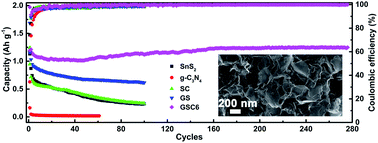Highly interdigitated and porous architected ternary composite of SnS2, g-C3N4, and reduced graphene oxide (rGO) as high performance lithium ion battery anodes†
Abstract
SnS2 is a two-dimensional (2D) layered transition metal dichalcogenide that has been extensively investigated as an anode for lithium ion batteries (LIBs). However, it generally undergoes a large volume change during cycling, resulting in severe capacity loss. Composites of SnS2 with carbon-based nanomaterials could deliver improved cyclic stability and rate performance. However, there is considerable room for performance improvement. In the present work, highly interdigitated porous nano-architectures of ternary composites consisting of 2D nanomaterials of SnS2, reduced graphene oxide (rGO), and graphitic carbon nitride (g-C3N4) were synthesized via a simple one-pot hydrothermal route. The synthesized ternary nanocomposites were characterized with high surface area, porous structure, and high pore volume. Due to the intimate face-to-face interactions offered by the 2D structured constituents, the obtained nanocomposites showed remarkably improved performances as anodes in LIBs. In particular, the galvanostatic charge–discharge performance depends on the amount of g-C3N4 in the nanocomposites. The composite containing 6.6 wt% g-C3N4 showed the best performance, attaining a specific capacity of 1248.4 mA h g−1 after 276 cycles with a coulombic efficiency of 99.9% at 100 mA g−1 along with an excellent rate performance. The outstanding performances of the composite anodes were attributed to the unique 3D porous structure, low charge transfer resistance, and high lithium ion diffusion coefficient, afforded by the synergistic effect of concurrent encompassing of rGO and g-C3N4 around the SnS2 platelets.


 Please wait while we load your content...
Please wait while we load your content...